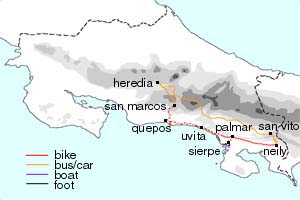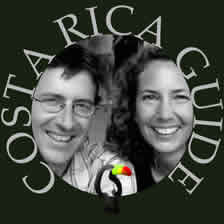
Heredia -> San Marcos (by car) -> Quepos -> Manuel Antonio -> Quepos -> Punta Uvita -> Ballena -> Palmar Norte -> Sierpe -> Palmar Norte -> Ciudad Neily
319 km and approximately 1,500 meters of elevation gain by bike
This tour included coastal rainforest, a lot of the beaches of the southern pacific coast and some of the mid elevation rainforest near the border with Panama. A couple of the highlights were the Ballena Marine Sanctuary and the Wilson Botanical Gardens.

After the Nicoya and Santa Rosa National Park camping tour we spent a few days in Heredia hanging out with Roman and Elysia at their coffee farm in San Francisco de Santo Domingo, Heredia. We took another Caribbean side adventure with Quincho to see the brand new Rainforest Aerial Tram.
When we got ready to roll on our bikes again Quincho drove us through San Jose, its western suburbs and into the mountains to San Marcos where the pavement ends. We would have had to take a bus if he hadn’t insisted on driving because the traffic is too dangerous for bikes.

In San Marcos we loaded the gear on our bicycles and continued up a gravel road to Napoles through coffee plantations and cattle ranches.
We entered the clouds at the ridge-crest above Napoles, and when we emerged on the way down the pasture had given way to virgin rainforest. The next 37 km down to Quepos were fantastic. Incredible vistas across forested gorges and hillsides so steep that the muddy rock strewn track we were following was at canopy level on the downhill side.
A lot of the most fascinating life in the rainforest is at the top, in the canopy. We had ridden the Rainforest Aerial Tram on the edge of Braulio Carrillo for an introduction to this ecosystem, and the views we got on this ride gave us a closer look at a more diverse range of canopy.

The mud and grit we had splashed from head to toe on our descent took its toll as we started cranking again on the rolling hills outside Quepos. One of the links in my chain was kinked and I felt it skip then catch and give way as it came around the front chain ring. It took about 15 minutes to remove the mangled link and get both of our chains cleaned and lubed well enough that they would flex freely.
In Quepos, the cabina manager took one look at us, and got a hose out so we got everything thoroughly cleaned up.
The descent had also finished off our brake pads, so we went searching for replacements.
There was a small bike shop in town, but they didn’t have anything that would fit. Luckily there were a couple of brothers spending part of their winter vacation from elementary school hanging out in the bike shop waiting for gringos to come in looking for hard to find parts.
They led the way to the hardware shop, where where there was a choice of two brands that would fit and they were super cheap. Eight brake pads would have cost closer to $50 at home than the $2.76 that the bill came to and needless to say I was quite appreciative of the boys help.
I handed the smaller one the few bucks change, and thanked them for their assistance.
A few minutes later they caught up as I was walking back to the cabina wanting me to clarify the division of the spoils.
My Spanish is not the greatest and when I handed over the colones and thanked them I had addressed them in the singular form. The seven year old was insisting that I meant for him to have it all, while the nine year old saw this as quite inequitable and wanted a cut.
When we saw them later, they both had ice cream cones and pockets bulging with goodies, so the explanation must have worked.



















